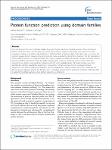Protein function prediction using domain families
Rentzsch, Robert
Orengo, Christine A.
Here we assessed the use of domain families for predicting the functions of whole proteins. These 'functional families' (FunFams) were derived using a protocol that combines sequence clustering with supervised cluster evaluation, relying on available high-quality Gene Ontology (GO) annotation data in the latter step. In essence, the protocol groups domain sequences belonging to the same superfamily into families based on the GO annotations of their parent proteins. An initial test based on enzyme sequences confirmed that the FunFams resemble enzyme (domain) families much better than do families produced by sequence clustering alone. For the CAFA 2011 experiment, we further associated the FunFams with GO terms probabilistically. All target proteins were first submitted to domain superfamily assignment, followed by FunFam assignment and, eventually, function assignment. The latter included an integration step for multi-domain target proteins. The CAFA results put our domain-based approach among the top ten of 31 competing groups and 56 prediction methods, confirming that it outperforms simple pairwise whole-protein sequence comparisons.
Dateien zu dieser Publikation
Keine Lizenzangabe
Verwandte Publikationen
Anzeige der Publikationen mit ähnlichem Titel, Autor, Urheber und Thema.
-
2012-12-21ZeitschriftenartikelProtein-Protein Interaction Domains of Bacillus subtilis DivIVA Baarle, Suey van; Celik, Ilkay Nazli; Kaval, Karan Gautam; Bramkamp, Marc; Hamoen, Leendert W.; Halbedel, SvenDivIVA proteins are curvature-sensitive membrane binding proteins that recruit other proteins to the poles and the division septum. They consist of a conserved N-terminal lipid binding domain fused to a less conserved ...
-
2013-03-11ZeitschriftenartikelTowards further reduction and replacement of animal bioassays in prion research by cell and protein misfolding cyclic amplification assays Boerner, Susann; Wagenführ, Katja; Daus, Martin L.; Thomzig, Achim; Beekes, MichaelLaboratory animals have long since been used extensively in bioassays for prions in order to quantify, usually in terms of median infective doses [ID50], how infectious these pathogens are in vivo. The identification of ...
-
2013-08-08ZeitschriftenartikelCytomegalovirus Downregulates IRE1 to Repress the Unfolded Protein Response Stahl, Sebastian; Burkhart, Julia M.; Hinte, Florian; Tirosh, Boaz; Mohr, Hermine; Zahedi, René P.; Sickmann, Albert; Ruzsics, Zsolt; Budt, Matthias; Brune, WolframDuring viral infection, a massive demand for viral glycoproteins can overwhelm the capacity of the protein folding and quality control machinery, leading to an accumulation of unfolded proteins in the endoplasmic reticulum ...

